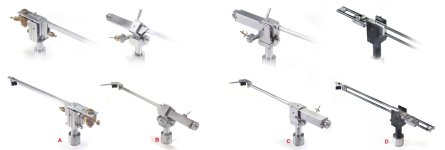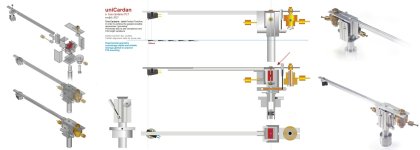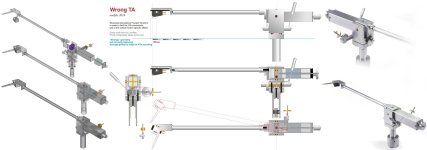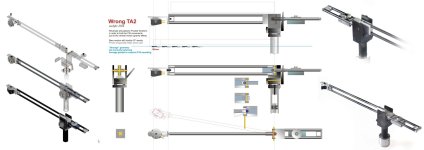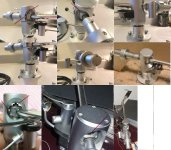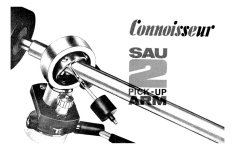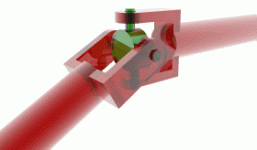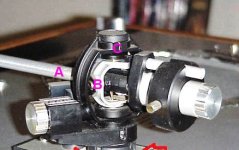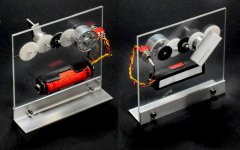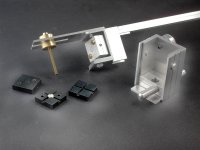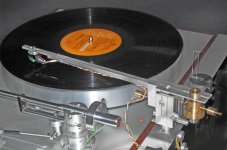Tired of trying to bypass the known problems of the different types of arms (PTA - LTA - PTTA = 15 working arms built...), often introducing just new issues, in the end I tried to make some clearly wrong ones. Wrong, but fully working.
1 - wrong mechanism (a true Cardan joint*, not a common gimbal - A+B)
2 - Vert / Hor articulations wrong switch (CW just on Vert. C+D)
Results? interesting, if not surprising: especially the Cardan 45° B
carlo
*https://en.wikipedia.org/wiki/Universal_joint
1 - wrong mechanism (a true Cardan joint*, not a common gimbal - A+B)
2 - Vert / Hor articulations wrong switch (CW just on Vert. C+D)
Results? interesting, if not surprising: especially the Cardan 45° B
carlo
*https://en.wikipedia.org/wiki/Universal_joint
Attachments
Something clearer - for those who, like me, still live in a 2D world - the working drawings.
c
thanks ripblade, DD, ST: as you know, there's something more behind than kicking the box
c
thanks ripblade, DD, ST: as you know, there's something more behind than kicking the box
Attachments
Carlo,
Did any of these "wrong" TAs result in identifiable "wrong" behavior or performance? Or - was the performance audibly somehow different? Have you heard anything in the music played through these arms that told you these are viable alternative designs or interesting dead ends?
Doug
Did any of these "wrong" TAs result in identifiable "wrong" behavior or performance? Or - was the performance audibly somehow different? Have you heard anything in the music played through these arms that told you these are viable alternative designs or interesting dead ends?
Doug
Hi Doug, part of the answer is already in the notes next to the drawings.
I don't trust my (and others) listening feels, just to mechanical measurements (not on signal ones, too many variables for my taste/skill). But consider that now the Cardan 45° (along with only 2 others out of all the ones I've built) is normally in use in the living room.
So I definitely wouldn't recommend them to those looking to replicate a $uper TA at home, but rather to those experimenters looking to investigate deeper into the real TA movements due to the weak tracing forces.
Some previous calcs and mockups helped to overcome the concerns related to the true Cardan bearing behavior (the 45° linearity is counterintuitive!) and the VTF variations in the WTA 1-2
c
I don't trust my (and others) listening feels, just to mechanical measurements (not on signal ones, too many variables for my taste/skill). But consider that now the Cardan 45° (along with only 2 others out of all the ones I've built) is normally in use in the living room.
So I definitely wouldn't recommend them to those looking to replicate a $uper TA at home, but rather to those experimenters looking to investigate deeper into the real TA movements due to the weak tracing forces.
Some previous calcs and mockups helped to overcome the concerns related to the true Cardan bearing behavior (the 45° linearity is counterintuitive!) and the VTF variations in the WTA 1-2
c
Hi Carlo,
Designing and building tonearms is a very though provoking exercise. I know from my perspective it's taught me a LOT about the behavior necessary for information retrieval. When one starts thinking about a TA as a precision measuring instrument rather than a musical instrument it alters the thought process. I know it did with me. I was originally hell bent on having a TA that has the same horizontal and vertical inertia. But when I thought about what the TA is doing in the groove and the forces involved it was obvious to me that horizontal inertia needed to be higher than vertical in order to hold the cartridge body as still as possible and specifically to prevent vertical articulation translating to horizontal movement. Viscous damping can also go some way to achieving this result but IMO is a bandaid solution.
Did you perform impulse testing on the TA's you built? If you remember the PTA I built I did a lot of hammer testing where I hung the TA and hit it with the handle of a screwdriver and recorded the results. This helped in designing the the CW and stub to control resonance, as well as the correct amount of damping inside the arm tube. Too much damping and it made the impulse test worse.
Designing and building tonearms is a very though provoking exercise. I know from my perspective it's taught me a LOT about the behavior necessary for information retrieval. When one starts thinking about a TA as a precision measuring instrument rather than a musical instrument it alters the thought process. I know it did with me. I was originally hell bent on having a TA that has the same horizontal and vertical inertia. But when I thought about what the TA is doing in the groove and the forces involved it was obvious to me that horizontal inertia needed to be higher than vertical in order to hold the cartridge body as still as possible and specifically to prevent vertical articulation translating to horizontal movement. Viscous damping can also go some way to achieving this result but IMO is a bandaid solution.
Did you perform impulse testing on the TA's you built? If you remember the PTA I built I did a lot of hammer testing where I hung the TA and hit it with the handle of a screwdriver and recorded the results. This helped in designing the the CW and stub to control resonance, as well as the correct amount of damping inside the arm tube. Too much damping and it made the impulse test worse.
The 45 Cardan bearing loads all 4 pivots equally, it seems to me, but all 4 are also in motion when the arm moves in any direction. This is quite different from the usual approach but I've seen it before in a commercial build. One would think such a bearing would have higher friction.
What was it you found interesting and why is it installed in your system in preference to the others, @nocdplz?
What was it you found interesting and why is it installed in your system in preference to the others, @nocdplz?
... When one starts thinking about a TA as a precision measuring instrument rather than a musical instrument it alters the thought process. I know it did with me. I was originally hell bent on having a TA that has the same horizontal and vertical inertia. But when I thought about what the TA is doing in the groove and the forces involved it was obvious to me that horizontal inertia needed to be higher than vertical in order to hold the cartridge body as still as possible and specifically to prevent vertical articulation translating to horizontal movement. Viscous damping can also go some way to achieving this result but IMO is a bandaid solution.
...
Could a tonearm be designed with vertical and horizontal servos and some means of moving it sideway along the groove based on some optical sensor?
The idea would be to keep the cartridge always centered on the groove, at the same vertical distance. The "tonearm" could be a high mass, I think it wouldn't matter anymore as the body of the cartridge would not move in response to the cantilever.
I guess the linear tracking tonearms are a first step that way?
I imagine that having built so many tonearms that the only significant change to the Cardanic, compared to your many others, is the pivot/joint area, so you are seeing and listening to the result of that change in comparison to others that you havent put on your "listening system".Hi Doug, part of the answer is already in the notes next to the drawings.
I don't trust my (and others) listening feels, just to mechanical measurements (not on signal ones, too many variables for my taste/skill). But consider that now the Cardan 45° (along with only 2 others out of all the ones I've built) is normally in use in the living room.
So I definitely wouldn't recommend them to those looking to replicate a $uper TA at home, but rather to those experimenters looking to investigate deeper into the real TA movements due to the weak tracing forces.
Some previous calcs and mockups helped to overcome the concerns related to the true Cardan bearing behavior (the 45° linearity is counterintuitive!) and the VTF variations in the WTA 1-2
c
Also the 45 is better than the 90.
Knowing that you prefer the results of the 45 solution in comparison to many others including the 90 leads one to ask why might it be better out of the many theories about good tonearm design, or does it open a new area?
I imagine that the arm with CW motion removed from the horizontal arc must relieve the cartridge from doing the work to move the CW through the horizontal arc normally seen. Many ambitions with TA design are to relieve the cartridge of unnecessary loads, and this seems relatively massive in that achievement.Tired of trying to bypass the known problems of the different types of arms (PTA - LTA - PTTA = 15 working arms built...), often introducing just new issues, in the end I tried to make some clearly wrong ones. Wrong, but fully working.
1 - wrong mechanism (a true Cardan joint*, not a common gimbal - A+B)
2 - Vert / Hor articulations wrong switch (CW just on Vert. C+D)
Results? interesting, if not surprising: especially the Cardan 45° B
Thanks for the questions, which I will try to answer in detail later, proceeding in order. It will take time, and your patience: and forgive my often confused thoughts, but this is reason why i'm posting this trials.
The first premise, instead, is to motivate these two directions of experimentation.
Over time I became in doubt if the visible movements of the arm along the H and V axes during positioning, or due to warps and eccentrics have very little to do with the non-visible ones due to tracing. (the real ones to consider?)
A thread promoted by Ralf on how the groove is engraved, and read has cleared up several claims on the topic (it tracks parallel how is cut...): the cantilever has only complex movements (along the surface of a cone) and the task of the arm is to average them, in order to keep the cartridge H+V centered in the groove. That's the only role of a TA, which instead tries to play others of his own, to write his signature.
This has led me to think that any dissymmetry - geometric, of masses and articulations - inevitably generates different distortion. (a common diyer's experience, called "color")
Hence the interest in a joint as close as possible to a unipivot, but without the known difficulty of mass distribution, and the efforts to somehow manage ths inertia on the horizontal plane vs. the inertia+weight force on vertical.
c
every single point of this is a long debated chapter with differing opinions, I know.
The first premise, instead, is to motivate these two directions of experimentation.
Over time I became in doubt if the visible movements of the arm along the H and V axes during positioning, or due to warps and eccentrics have very little to do with the non-visible ones due to tracing. (the real ones to consider?)
A thread promoted by Ralf on how the groove is engraved, and read has cleared up several claims on the topic (it tracks parallel how is cut...): the cantilever has only complex movements (along the surface of a cone) and the task of the arm is to average them, in order to keep the cartridge H+V centered in the groove. That's the only role of a TA, which instead tries to play others of his own, to write his signature.
This has led me to think that any dissymmetry - geometric, of masses and articulations - inevitably generates different distortion. (a common diyer's experience, called "color")
Hence the interest in a joint as close as possible to a unipivot, but without the known difficulty of mass distribution, and the efforts to somehow manage ths inertia on the horizontal plane vs. the inertia+weight force on vertical.
c
every single point of this is a long debated chapter with differing opinions, I know.
Last edited:
So, with the premise or assumption that a uni pivot is a desirable and effective joint for a good TA and a cardan behaves similarly, why might a cardan be better and why might a 45 cardan be better than a 90.
By the way, i ask these questions with a very open mind to learn something. My own little experimentations have been with radials, so this is not an area where i have any knowledge or confusion! Only questions, no answers.
By the way, i ask these questions with a very open mind to learn something. My own little experimentations have been with radials, so this is not an area where i have any knowledge or confusion! Only questions, no answers.
The Connoisseur SAU2 arm (from the 1970s) used 45 degree Cardan because although it increases friction by a factor of root(2) it allowed elegant bias compensation.
That's interesting EC8010, i tried to find a picture on the net, and found only descriptions, they describe it as a gimbal rather than a Cardan, do you know the difference and which it is by any chance?
Interesting, EC 8010. I'd found no true cardan joint (even at 90°) around till now - Even the Thorens tp11 - 16 or even more the Fidelity Researrch FR24 that were said to use, just seemed to have it but were common gimbal.
And that, with thousands gimballed PTA sold, seemed very strange to me.
May you post some further info?
thanks - c
And that, with thousands gimballed PTA sold, seemed very strange to me.
May you post some further info?
thanks - c
Attachments
Found by myself - but, again, seems just a gimbal with 45° axis (very interesting!) not a true Cardanic joint. (we italians are proud of our Gerolamo Cardano) *https://en.wikipedia.org/wiki/Universal_joint.
thks again EC8010 - c
thks again EC8010 - c
Attachments
Thanks for the pics attached, could you kindly note what the pics posted show please and also (please!) explain the difference between a true cardan and gimbals?Interesting, EC 8010. I'd found no true cardan joint (even at 90°) around till now - Even the Thorens tp11 - 16 or even more the Fidelity Researrch FR24 that were said to use, just seemed to have it but were common gimbal.
And that, with thousands gimballed PTA sold, seemed very strange to me.
May you post some further info?
thanks - c
Sorry, since there is a true cardanic joint on billions cars and other common devices, I thought it was known.
In the Cardanic joint there is a third separate element that, via 2+2 bearings, connects the two axles supports ; in gimballed TAs the A wand supports the vertical articulation, and the B intermediate element the horizontal one to C basis
Wiki and Thorens explain much better than me (attachment)
c
joint frictions - obviously there are tons of literature about (with math often out of my reach). In our case we must consider that, in the case of H or V movement the friction is certainly greater than that of a single bearing, but with a combined H+V movement (i.e. always, imo)?
In the Cardanic joint there is a third separate element that, via 2+2 bearings, connects the two axles supports ; in gimballed TAs the A wand supports the vertical articulation, and the B intermediate element the horizontal one to C basis
Wiki and Thorens explain much better than me (attachment)
c
joint frictions - obviously there are tons of literature about (with math often out of my reach). In our case we must consider that, in the case of H or V movement the friction is certainly greater than that of a single bearing, but with a combined H+V movement (i.e. always, imo)?
Attachments
Could a tonearm be designed with vertical and horizontal servos and some means of moving it sideway along the groove based on some optical sensor?
The idea would be to keep the cartridge always centered on the groove, at the same vertical distance. The "tonearm" could be a high mass, I think it wouldn't matter anymore as the body of the cartridge would not move in response to the cantilever.
I guess the linear tracking tonearms are a first step that way?
The problem is a servo needs an error to track and we're trying to retrieve modulations in a groove that measure in nano metres. It is impossible to keep the cartridge perfectly centered on the groove. All we can achieve is to reduce the error as much as possible and warps/eccentricity make this job even harder.
A TA needs to not just hold the cartridge centered and still, it also needs to deal with the enormous amount of energy created by the stylus tracing the groove. Put a stethoscope on the base of a TA and you will clearly hear the music. The fact you can hear music means the TA is vibrating which intern is also moving the TA hence moving the cartridge body WRT the stylus creating an unwanted signal.
Cue the stylus on a stationary record and listen to the output of the phono pre with headphones and clap your hands near the cartridge and you can hear the clap in the headphones. The point I'm making here is that a Phono Cartridge is one of the most sensitive seismic transducers known, a TA has a tough job to allow the cartridge to track an LP with warps and eccentricity and hold the cartridge body still. Infact the TA is usually the largest source of colouration in the vinyl playback chain.
Let's start from the easier side, the True Cardan joint
From those #11 premises it follows that:
To verify the role of these severe statements, and the importance of the coherence of the movements on the two V+H axes I had added this device ( the "Torquemada torture" as Doug called it) to my usual set of mechanical measures (from the stetho + microscope observation and videos, to the pendulums and sinebar for friction and skating measures, compliance and VTF+ impulse test sets) already known on others threads. It simulates what happens at 33 rpm on warp+eccentrics of increasing amplitudes.
Very few of my arms fully passed that test, and not only the linear and tangential ones, as expected, but also many pivoted ones clearly showed their dissymmetries (increasing elliptic motion)
To understand better and see them in action I designed an arm with adjustable tuning of the eff. mass and the vertical position of the CW . While designing I thought it was also suitable to implement a true cardan joint; as mentioned I was curious to understand why no one had ever used it, and to see what happened. Where was the problem?
Once built and set up correctly the Unicardan behavior was nice, beyond previous fears, and the cardan joint aided to get a fluid, circular Torquemada movement.
Despite being made without any concern for resonances (an open and composite structure does not promise anything good) the arm also sounded clean, crisp, typically unipivot. I attributed this quality not only to the mechanical tuning but also to having avoided to split of the resonances grounding on the two separate patterns.
...to be continued - c
sorry - the video was done with my Easy Pi linear - I hadn't made with these arms because, at the time, I didn't think of posting - if you're interested I'll do (calmly)
From those #11 premises it follows that:
- the mass centroids must be aligned on the stylus tip to pivot axis
- the V&H articulations must be coincident (or better, unique) in a point aligned to previous axis
To verify the role of these severe statements, and the importance of the coherence of the movements on the two V+H axes I had added this device ( the "Torquemada torture" as Doug called it) to my usual set of mechanical measures (from the stetho + microscope observation and videos, to the pendulums and sinebar for friction and skating measures, compliance and VTF+ impulse test sets) already known on others threads. It simulates what happens at 33 rpm on warp+eccentrics of increasing amplitudes.
Very few of my arms fully passed that test, and not only the linear and tangential ones, as expected, but also many pivoted ones clearly showed their dissymmetries (increasing elliptic motion)
To understand better and see them in action I designed an arm with adjustable tuning of the eff. mass and the vertical position of the CW . While designing I thought it was also suitable to implement a true cardan joint; as mentioned I was curious to understand why no one had ever used it, and to see what happened. Where was the problem?
Once built and set up correctly the Unicardan behavior was nice, beyond previous fears, and the cardan joint aided to get a fluid, circular Torquemada movement.
Despite being made without any concern for resonances (an open and composite structure does not promise anything good) the arm also sounded clean, crisp, typically unipivot. I attributed this quality not only to the mechanical tuning but also to having avoided to split of the resonances grounding on the two separate patterns.
...to be continued - c
sorry - the video was done with my Easy Pi linear - I hadn't made with these arms because, at the time, I didn't think of posting - if you're interested I'll do (calmly)
Attachments
Last edited:
- Home
- Source & Line
- Analogue Source
- the "Wrong" Tonearms

